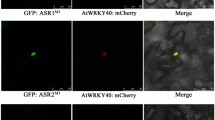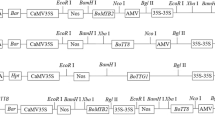Abstract
The glutathione S- transferase encoded by Bronze2 performs the last genetically defined step in maize anthocyanin biosynthesis, being required for pigment sequestration into vacuoles. The Bz2 primary transcript contains a single intron; in maize leaves both spliced and unspliced Bz2 transcripts are usually present and are predicted to encode 26 and 14 kDa proteins, respectively. To increase understanding of the role and regulation of Bz2 transcript splicing, we examined Bz2 expression during development in transgenic maize plants expressing a 35S:Bz2 (35S:mycBz2i) gene and, by transient expression analysis, in Black Mexican Sweet maize protoplasts. We show here that the gene is expressed in diverse tissues that lack functional copies of one or both transcription factors regulating anthocyanin synthesis, that transcript levels are much higher when the R/B plus C1/Pl transcription factors are present, and that the splicing decision depends on local sequence context. The predicted 14 kDa protein was never detected indicating that unspliced transcripts are likely to be non-coding. The native 26 kDa BZ2 protein is loosely membrane-bound, but it was detectable only in tissues accumulating anthocyanin. Consequently, BZ2 accumulation appears to be limited by stringent post-transcriptional regulation.
Similar content being viewed by others
References
Alfenito, M.R., Souer, E., Goodman, C.D., Buell, R., Mol, J., Koes, R. and Walbot, V. 1998. Functional complementation of anthocyanin sequestration in the vacuole by widely divergent glutathione S-transferases. Plant Cell 10: 1135–1149.
Bodeau, J.P. and Walbot, V. 1992. Regulated transcription of the maize Bronze2 promoter in electroporated protoplasts requires the C1 and R gene products. Mol. Gen. Genet. 233: 379–387.
Casati, P. and Walbot, V. 2003. Gene expression profiling in response to ultraviolet radiation in maize genotypes with varying flavonoid content. Plant Physiol. 132: 1739–1754.
Cobbett, C.S., May, M.J., Howden, R. and Rolls, B. 1998. The glutathione-deficient, cadmium-sensitive mutant, cad2-1, of Arabidopsis thaliana is deficient in gamma-glutamylcysteine synthetase. Plant J. 16: 73–78.
Coe, E.H., Hoisington, D.A. and Neuffer, M.G. 1988. The genetics of corn. In: G.F. Sprague and J. Dudley (Eds.) Corn and Corn Improvement, American Society of Agronomy, Madison, WI, pp. 81–258.
Dixon, D.P., Lapthorn, A. and Edwards, R. 2002. Plant glutathione transferases. Genome Biol. 3, rev. 3004.1–3004.10.
Edwards, R., Dixon, D.P. and Walbot, V. 2000. Plant glutathione S-transferases: enzymes with multiple functions in sickness and in health. Trends Plant Sci. 5: 193–198.
Fisher, R.F. and Long, S.R. 1992. Rhizobium-plant signal exchange. Nature 357: 655–660.
Grotewold, E., Sainz, M.B., Tagliani, L., Hernandez, J.M., Bowen, B. and Chandler, V.L. 2000. Identification of the residues in the Myb domain of maize C1 that specify the interaction with the bHLH cofactor R. Proc. Natl. Acad. Sci. USA 97: 13579–13584.
Harborne, J.B. and Self, R. 1987. Malonated cyaniding 3-glucosides in Zea mays and other grasses. Phytochemistry 26: 2417–2418.
Ishikawa, T. 1992. The ATP-dependent glutathione S-conjugate export pump. Trends Biochem. Sci. 17: 463–468.
Laemmli, U.K. 1970. Cleavage of structural proteins during the assembly of the head of bacteriophage T4. Nature 227: 680–685.
Levine, A.R., Tenhaken, R., Dixon, R. and Lamb, C. 1994. H2O2 from the oxidative burst orchestrates the plant hypersensitive disease resistance response. Cell 79: 583–593.
Li, Z.-S., Zhao, Y. and Rea, P.E. 1995. Magnesium adenosine 5′-triphosphate-energized transport of glutathione S-conjugates by plant vacuolar membrane vesicles. Plant Physiol. 107: 1257–1268.
Marrs, K.A. 1996. The functions and regulation of glutathione S transferases in plants. Annu. Rev. Plant Physiol. Plant Mol. Biol. 47: 127–158.
Marrs, K.A. and Walbot, V. 1997. Expression and RNA splicing of the maize glutathione S-transferase Bronze2 gene is regulated by cadmium and other stresses. Plant Physiol. 113: 93–102.
Marrs, K., Alfenito, M.R., Lloyd, A.M. and Walbot, V. 1995. A glutathione S- transferase involved in vacuolar transfer encoded by the maize gene Bronze2. Nature 375: 397–400.
McLaughlin M. and Walbot, V. 1987. Cloning of a transposable Bz2 allele of maize by transposon tagging and differential hybridization. Genetics 117: 771–776.
Mo, Y., Nagel, C. and Taylor, L. 1992. Biochemical complementation of chalcone synthase mutants defines a role for flavonols in functional pollen. Proc. Natl. Acad. Sci. USA 89: 7213–7217.
Mol J., Grotewold, E. and Koes, R. 1998. AUTHOR: PLEASE PROVIDE PAPER TITLE. Trends Plant Sci 3: 212–217.
Mozer, T.J., Tiemeier, D.C. and Jaworski, E.G. 1983. Purification and characterization of corn glutathione S-transferases. Biochemistry 22: 1068–1072.
Mueller, L.A., Goodman, C.D., Silady, R.A. and Walbot, V. 2000. AN9, a Petunia glutathione S-transferase required for anthocyanin sequestration, is a flavonoid-binding protein. Plant Physiol. 123: 1561–1570.
Nash, J. and Walbot, V. 1992. Bronze-2 gene expression and intron splicing patterns in cells and tissues of Zea mays L. Plant Physiol. 100: 464–471.
Nash, J., Luehrsen, K.R. and Walbot, V. 1990. Bronze-2 gene of maize: reconstruction of a wild-type allele and analysis of transcription and splicing. Plant Cell 2: 1039–1049.
Plewa, M.J. and Wagner, E.D. 1993. Activation of promutagens by plants. Annu. Rev. Genet. 27: 93–113.
Raizada, M.N. and Walbot, V. 2000. The late developmental pattern of Mu transposon excision is conferred by a cauliflower mosaic virus 35S-driven MURA cDNA in transgenic maize. Plant Cell 12: 5–22.
Rea, P. 1999. MRP subfamily ABC transporters from plants and yeast. J. Exp. Bot. 50: 895–913.
Sandermann, H. 1992. Plant metabolism of xenobiotics. Trends Biochem. Sci. 17: 82–84.
Saslowsky, D. and Winkel-Shirley, B. 2001. Localization of flavonoid enzymes in Arabidopsis roots. Plant J. 27: 37–48.
Stapleton, A. and Walbot, V. 1994. Flavonoids can protect maize DNA from UV damage. Plant Physiol. 105: 881–889.
Walbot, V., Benito, M.-I., Bodeau, J. and Nash, J. 1994. Abscisic acid induces pink pigmentation in maize aleurone tissue in the absence of Bronze2. Maydica 39: 19–28.
Winkel-Shirley, B. 2001a. Flavonoid biosynthesis: a colorful model for genetics, biochemistry, cell biology and biotechnology. Plant Physiol. 126: 485–493.
Winkel-Shirley, B. 2001b. It takes a garden. How work on diverse plant species has contributed to an understanding of flavonoid metabolism. Plant Physiol. 127: 1399–1404.
Author information
Authors and Affiliations
Corresponding author
Rights and permissions
About this article
Cite this article
Pairoba, C.F., Walbot, V. Post-transcriptional regulation of expression of the Bronze2 gene of Zea mays L.. Plant Mol Biol 53, 75–86 (2003). https://doi.org/10.1023/B:PLAN.0000009267.76482.ce
Issue Date:
DOI: https://doi.org/10.1023/B:PLAN.0000009267.76482.ce




